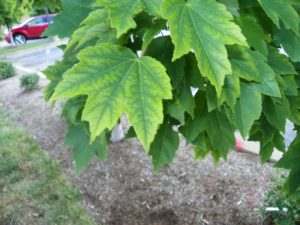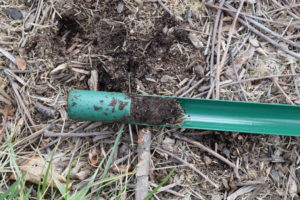An abiotic stress in plants is a stress due to a non-living factor, such as temperature, moisture, herbicides, etc. Biotic stress includes a living organism, such as a fungi, insect, etc. This series will explore some of the most common types of abiotic stress you may find in landscapes and nurseries.
What is wrong with this maple?
- Figure 1. Yellowing between the veins (interveinal chlorosis) on maple is typically due to manganese (Mn) deficiency in high pH soils.
How would you correct the problem?
If you guessed manganese deficiency, you would be correct. In areas with high pH, such as many locations in the Midwest, manganese (Mn) deficiency in maple is very common. When the pH of the soil is above 7, manganese is not readily available to the plant, even if there are sufficient amounts of manganese in the soil. As the pH of the soil increases, manganese is less and less available. We tend to begin seeing manganese deficiency when the pH is above 6.3 (Fig. 1). The pH of soil is just as important to plant health as the amount of nutrients that are in the soil (Fig. 2).
- Figure 2. Nutrient availability is determined by the pH of soil. Adapted from the Corn & Soybean Field Guide (Purdue Extension publication ID-179).
On a similar note, plants in the Ericaceae (heath or heather) family (i.e. azalea, rhododendron, blueberries) are found in naturally acidic soils. These plants exhibit iron (Fe) deficiencies and not typically manganese deficiencies. If you take a look at Figure 2, you will notice that both manganese and iron are not readily available at higher soil pH. The symptoms of manganese and iron are similar in appearance, with both exhibiting interveinal (yellowing between the veins of the leaf) chlorosis (Fig. 1).
Where did the plant come from?
If a neutral pH is 7, anything below is acidic and anything above is basic, or alkaline (Fig. 2). Though plants vary in their requirements, based on where they are found in the native range, most ornamental plants prefer slightly acidic soil conditions. Knowing where a plant is found growing wild will give you an idea of the requirements of that plant. For example, silver maple and sycamore are found in bottomlands with slightly acidic soils and poor drainage. Knowing where these plants are found in nature will tell you that they have a shallower root system (due to water-logged soils), thus are more tolerant of compacted soils.
So what determines a soils pH? Why does the majority of the Midwest have slightly alkaline soils?
The primary factor that determines a soil’s pH is the parent material, or bedrock. In most locations that have limestone (CaCO3) as the parent material, you will typically have a higher pH soil. Soil particles have charges that attract ions. When there are more hydrogen (H) ions in the soil, the pH is acidic. When there are more hydroxide (HO) ions in the soil, the pH is basic. The calcium in the limestone is attracted to the soil particles, which, in turn, leaves more hydroxide ions in the soil, thus making the pH more basic.
The soil pH scale is logarithmic, which means that each change in pH is ten times the next number. For example, a pH of six is ten times more acidic than a pH of seven, a pH of five is 100 times more acidic than seven, and a pH of four is 1,000 times more acidic than a pH of seven. To go the other direction, a pH of eight is ten times more basic than a pH of seven, and a pH of nine is 100 times more basic than a pH of seven. Though a change in pH from seven to six doesn’t sound like much, this logarithmic scale is the primary reason is takes a significant amount of product over a period of time to change soil pH.
Taking Steps to Correct the Problem
To determine the pH of your soil, it’s always recommended to send off to a laboratory (Fig. 3). Without a soil analysis, you will not know how much the pH needs to be raised or lowered, or what nutrients are in the soil. You need a starting point to determine what, if anything, needs to be changed in the soil. Though the Purdue Plant and Pest Diagnostic Laboratory does not conduct soil analysis, they have a list of soil testing labs that can be found at https://ag.purdue.edu/btny/ppdl/Pages/servicesandfees.aspx.
- Figure 3. Soil analysis needs to be completed prior to raising or lowering the pH of your soil
There are products than can be applied to the soil to increase or decrease pH. Tables one and two indicate the amounts of limestone needed to raise the pH and the common products that can be beneficial to raise the pH. Tables three and four list the amounts of sulfur needed to lower the pH and common products to help lower the pH.
- Table 1. Amount of limestone needed to raise pH of 7 inch layer of soil. Adapted from Possen, UCCE.
- Table 2. Common liming materials. Adapted from Possen, UCCE.
- Table 3. Tons of sulfur needed per acre to lower pH to 6.5. Adapted from Possen, UCCE.
- Table 4. Commonly used materials to lower pH and their equivalent amendment values. Adapted from Possen, UCCE.
Conclusion
Remember to always confirm the pH of the soil prior to any action. If the pH of your soil is either too high or too low, no matter if there are plenty of nutrients in the soil, they may not be available to the plant. Steps to correct pH of your soil will take time, so don’t expect a magical bullet that will cure the problem overnight. When thinking about changing the soil pH, patience is a virtue.
Purdue University resources:
Fertilizing Woody Plants: https://www.extension.purdue.edu/extmedia/HO/HO-140-W.pdf
Alkalinity Management in Soilless Substrates: https://www.extension.purdue.edu/extmedia/HO/HO-242-W.pdf
Lowering Soil pH for Horticultural Crops: https://www.extension.purdue.edu/extmedia/HO/HO-241-W.pdf
Soil pH: https://www.extension.purdue.edu/extmedia/HO/HO-240-W.pdf
pH and Electrical Conductivity in Soilless Substrates: https://www.extension.purdue.edu/extmedia/HO/HO-237-W.pdf
Medicion de pH y Conductividad Electrica en Sustratos: https://www.extension.purdue.edu/extmedia/HO/HO-237-SW.pdf
Fundamentals of Soil Cation Exchange Capacity (CEC): https://www.extension.purdue.edu/extmedia/AY/AY-238.html
Sources:
Possen, V. Changing pH of soil. University of California Cooperative Extension. https://vric.ucdavis.edu/pdf/soil/ChangingpHinSoil.pdf . Last accessed 8/18/2018






